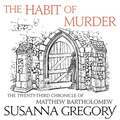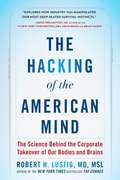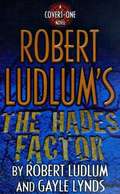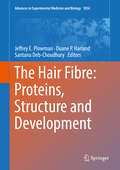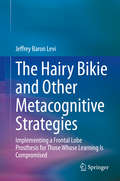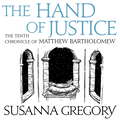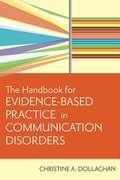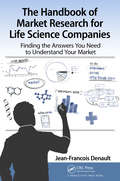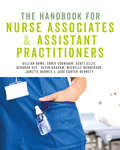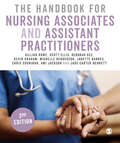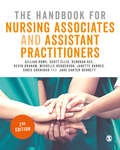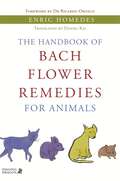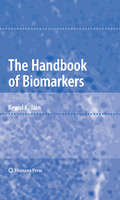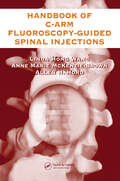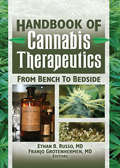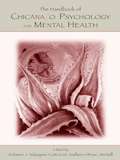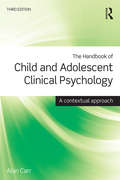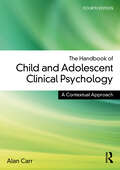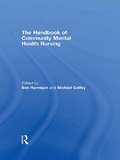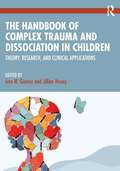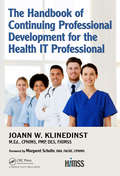- Table View
- List View
The Habit of Murder: The Twenty Third Chronicle of Matthew Bartholomew (Chronicles of Matthew Bartholomew #23)
by Susanna GregoryThe twenty third chronicle of Matthew Bartholomew. In 1360 a deputation from Cambridge ventures to the Suffolk town of Clare in the hope that the wealthy Elizabeth de Burgh has left a legacy to Michaelhouse. Yet when they arrive they discover that the report of her death is false and that the college seems destined for bankruptcy.Determined to see if some of its well-heeled citizens can be persuaded to sponsor Michaelhouse, Matthew Bartholomew, Brother Michael and Master Langelee become enmeshed in the town's politics. They quickly discover that a great many other people in Clare have recently met untimely deaths. These killings, combined with the arrogance Lady de Burgh has shown over the refurbishment of the church and the grotesque behaviour of some of her entourage, have created a dangerous restlessness in the town: an atmosphere intensified when yet more murders occur.One of the victims is a fellow traveller of the Michaelhouse contingent, and Matthew Bartholomew and Brother Michael feel honour-bound to identify his killer. It is a hunt which takes them deep into Clare's murky foundations and which threatens their own survival as well as that of their beloved college.'A first-rate treat for mystery lovers' (Historical Novels Review)'Susanna Gregory has an extraordinary ability to conjure up a strong sense of time and place' (Choice)
The Hacking of the American Mind: The Science Behind the Corporate Takeover of Our Bodies and Brains
by Robert H. Lustig"Explores how industry has manipulated our most deep-seated survival instincts."—David Perlmutter, MD, Author, #1 New York Times bestseller, Grain Brain and Brain MakerThe New York Times–bestselling author of Fat Chance reveals the corporate scheme to sell pleasure, driving the international epidemic of addiction, depression, and chronic disease. While researching the toxic and addictive properties of sugar for his New York Times bestseller Fat Chance, Robert Lustig made an alarming discovery—our pursuit of happiness is being subverted by a culture of addiction and depression from which we may never recover. Dopamine is the “reward” neurotransmitter that tells our brains we want more; yet every substance or behavior that releases dopamine in the extreme leads to addiction. Serotonin is the “contentment” neurotransmitter that tells our brains we don’t need any more; yet its deficiency leads to depression. Ideally, both are in optimal supply. Yet dopamine evolved to overwhelm serotonin—because our ancestors were more likely to survive if they were constantly motivated—with the result that constant desire can chemically destroy our ability to feel happiness, while sending us down the slippery slope to addiction. In the last forty years, government legislation and subsidies have promoted ever-available temptation (sugar, drugs, social media, porn) combined with constant stress (work, home, money, Internet), with the end result of an unprecedented epidemic of addiction, anxiety, depression, and chronic disease. And with the advent of neuromarketing, corporate America has successfully imprisoned us in an endless loop of desire and consumption from which there is no obvious escape. With his customary wit and incisiveness, Lustig not only reveals the science that drives these states of mind, he points his finger directly at the corporations that helped create this mess, and the government actors who facilitated it, and he offers solutions we can all use in the pursuit of happiness, even in the face of overwhelming opposition. Always fearless and provocative, Lustig marshals a call to action, with seminal implications for our health, our well-being, and our culture.
The Hades Factor (Covert-One #1)
by Robert Ludlum Gayle LyndsA homeless man in Boston, an Army Major in California, and a teenage girl in Atlanta all die suddenly and painfully--each a victim of an unknown doomsday virus. For three days, a team of scientists in a U.S. government laboratory has been frantically trying to unlock the virus's secrets. When the leading researcher from that lab, Lt. Col. Jonathan Smith, returns from overseas, he barely survives a series of well-orchestrated attempts made on his life. By the time Smith eludes his pursuers and makes it home, he discovers that the virus has claimed its fourth victim, Dr. Sophia Russell--Smith's fiancee. Devastated and enraged, Smith quickly uncovers evidence that his lover's death was no accident--that someone out there has the virus, and the pandemic that threatens hundreds of millions of lives is no accident. But wherever he turns, Smith finds that some unseen force has blocked his quest for information. Not knowing whom to trust, Smith assembles a private team to search for the truth behind the deadly virus. While the death toll mounts, their quest leads to the highest levels of power and the darkest corners of the earth, as they match wits with a determined genius--and as the fate of the world lies in the balance.
The Hair Fibre: Proteins, Structure and Development (Advances in Experimental Medicine and Biology #1054)
by Jeffrey E. Plowman Duane P. Harland Santanu Deb-ChoudhuryHair is a sophisticated bio-based material, whether it is on a human head or part of a mammalian coat. In particular, the role of the proteins in the follicle, integral to hair development, are not well understood. This new book seeks to integrate the latest research in proteomic and morphological studies into a coherent description of fibre development from the follicle to its final mature, keratinized form.To achieve this the book has been divided into three sections. The first describes the keratins, their associated proteins and how they assemble into intermediate filaments in the fibre. The second covers the latest information on the morphological changes that occur from the base of the follicle, through the keratinization process to the mature fibre and the role that proteins play in this. The final section delves into fundamental fibre properties such as crosslinking, thermal and oxidative modifications and how these affect the mature fibre.The editors of this book are internationally recognised for their work in the area of mammalian hair, Jeffrey Plowman for his knowledge of the proteomics of the fibre, Santanu Deb-Choudhury for his work in the area of crosslinking in the fibre and Duane Harland for his understanding of the morphological development of the fibre. Together they have collected material from other international experts: Leopold Eckhart and Florian Ehrlich for their knowledge of the evolution of keratins; Dong Dong Wu and David Irwin for their studies on keratin associated protein evolution; David Parry and Bruce Fraser for their work on keratin and keratin associated protein structure and assembly; John McKinnon for his studies on macrofibril formation; Crisan Popescu for the thermodynamics of keratins; and Jolon Dyer for his oxidative modification studies of keratins. This book provides a comprehensive introduction, and useful reference guide to hair biology and will be of interest to both scientists and technologists.
The Hairy Bikie and Other Metacognitive Strategies: Implementing a Frontal Lobe Prosthesis for Those Whose Learning Is Compromised
by Jeffrey Baron LeviThe book contains practical and innovative strategies to train clients with Traumatic Brain Injury, Autism, Intellectual Impairment and Behavioural Disorders to compensate for their deficits and to function independently within their environments. The book is a result of 30 years of working directly with clients who are experiencing problems with organization, memory, learning, problem solving and anger management. The book is highly recommended for practitioners working with clients with a range of disability in educational, community or work settings and is a valuable tool to researchers and tertiary institutions to impart this knowledge to future practitioners. The book is highly recommended to be included in a cognitive rehabilitation course for counsellors, neuropsychologists, rehabilitation consultants and vocational rehabilitation consultants. It would be highly relevant for a section in a Special Education course and for school psychologists, special education and mainstream teachers working with children with learning and behavioural disorders.
The Hand Of Justice: The Tenth Chronicle of Matthew Bartholomew (Chronicles of Matthew Bartholomew #10)
by Susanna GregoryFor the twentieth anniversary of the start of the Matthew Bartholomew series, Sphere is delighted to reissue all of the medieval monk's cases with beautiful new series-style covers.------------------------------------The winter of 1353 has been appallingly wet, there is a fever outbreak amongst the poorer townspeople and the country is not yet fully recovered from the aftermath of the plague. The increasing reputation and wealth of the Cambridge colleges are causing dangerous tensions between the town, Church and University. Matthew Bartholomew is called to look into the deaths of three members of the University of who died from drinking poisoned wine, and soon he stumbles upon criminal activities that implicate his relatives, friends and colleagues - so he must solve the case before matters in the town get out of hand...In February 1355, amid the worst snows in living memory, two well-born murderers return to Cambridge after receiving the King's pardon - but they show no remorse, and are in fact ready to confront those who helped convict them. When Matthew Bartholomew is called to the local mill to examine two corpses, he and Brother Michael know who to question, but in the fledgling university city, nothing is ever as straightforward as it seems...
The Hand Of Justice: The Tenth Chronicle of Matthew Bartholomew (Chronicles of Matthew Bartholomew #10)
by Susanna GregoryIn Cambridge 1355 the colleges of the fledgling university are as much at odds with each other as they are with the ordinary townfolk. This tension has recently been heightened by the return of two well-born murderers after receiving the King's pardon, showing no remorse but ready to confront those who helped convict them. And in the midst of this Bartholomew the physician is called to the local mill to examine two corpses. It is almost a relief to be able to turn his back on the fractious town, but as always in Cambridge nothing is disconnected.
The Handbook For Evidence-Based Practice In Communication Disorders
by Chris DollaghanWith this landmark textbook, speech-language pathologists will learn to apply current best evidence as they make critical decisions about the care of each individual they serve. The first text that covers this cutting-edge topic for the communication disorders field, this book introduces SLPs to the principles and process of evidence-based practice, thoroughly covering its three primary components: "external" evidence from systematic research, "internal" evidence from clinical practice, and evidence concerning patient preferences. <p><p> Developed by Christine A. Dollaghan, one of the most highly respected researchers in the field of language acquisition and disorders, this text makes complex concepts understandable with its clear, reader-friendly language, vivid step-by-step examples of key processes, and illuminating figures and tables. <p> SLPs will come away with a solid, practical understanding of evidence-based practice--knowledge they'll use throughout their careers to make sound clinical decisions about the screening, diagnosis, and treatment of communication disorders.
The Handbook for Market Research for Life Sciences Companies: Finding the Answers You Need to Understand Your Market
by Jean-Francois DenaultAs innovation moves from the lab to the market, a new research phase begins for the entrepreneur: the market research phase. Inspired by a new technology that can change the world, critical questions need to be addressed. Is there a market for my innovation? Who are my clients? What do they need? Is my innovation filling that gap in the market? Who are my competitors? How are they approaching the market? If these questions are unaswered, entrepreneurs meet potential investors or partners with only a basic understanding of their market. The objective of this book is to fill this gap. It is a practical manual that gives entrepreneurs real-world advice and tools to build a solid market model. The book provides tips, models and tools entrepreneurs can use to collect, interpret and present their market and integrate it into their business plan. What the entrepreneur learns in this book will help him throughout his journey. After going over the market research process, he will learn how to design and use a number of market research tools, and how to adapt them in a life science context. From building a web survey to preparing interviews to doing your own secondary research, this handbook will help him gain a comprehensive understanding of how to perform his own market research activities and how to analyze his data. Finally, a number of frameworks (such as the TAM-SAM-SOM as well as the KANO Model) are described so that he can efficiently share what he has learned, using models that simply yet effectively shares findings.
The Handbook for Nurse Associates and Assistant Practitioners
by Kevin Graham Gillian Rowe Chris Counihan Scott Ellis Deborah Gee Michelle Henderson Janette Barnes Jade Carter-BennettWritten specifically for students who are undertaking a foundation degree or higher level apprenticeship in healthcare practice, or for those studying for the new nurse associate role, this book provides readers with the core knowledge and skills, giving them a springboard to further study. Key features include: a one-stop shop for the course including a broad range of topics such as study skills, professional development, infection control and health promotion, health sciences, mental health, learning disabilities, children and families, clinical case studies throughout to show how theory relates to real-life practice different levels of activity to help students ‘step up learning’ whether they are at level 4 or 5 Written by a wide range of authors with both experience in practice and in running degrees in nursing and health, the book is essential reading for all healthcare support workers, assistant practitioners and nurse associates.
The Handbook for Nurse Associates and Assistant Practitioners
by Kevin Graham Gillian Rowe Chris Counihan Scott Ellis Deborah Gee Michelle Henderson Janette Barnes Jade Carter-BennettWritten specifically for students who are undertaking a foundation degree or higher level apprenticeship in healthcare practice, or for those studying for the new nurse associate role, this book provides readers with the core knowledge and skills, giving them a springboard to further study. Key features include: a one-stop shop for the course including a broad range of topics such as study skills, professional development, infection control and health promotion, health sciences, mental health, learning disabilities, children and families, clinical case studies throughout to show how theory relates to real-life practice different levels of activity to help students ‘step up learning’ whether they are at level 4 or 5 Written by a wide range of authors with both experience in practice and in running degrees in nursing and health, the book is essential reading for all healthcare support workers, assistant practitioners and nurse associates.
The Handbook for Nursing Associates and Assistant Practitioners
by Kevin Graham Gillian Rowe Chris Counihan Scott Ellis Deborah Gee Michelle Henderson Janette Barnes Jade Carter-Bennett Ami JacksonThe essential handbook for trainee nursing associates and anyone undertaking a foundation degree or higher-level apprenticeship in healthcare practice. This bestselling book will see you through all aspects of your programme, from the skills and knowledge you need to get started through to more advanced topics such as leadership and pathophysiology. Covering all of the topics you will study in clear, straightforward language, it builds your confidence and competence as an effective healthcare professional. Key features: - Mapped to the 2018 NMC Standards and other relevant healthcare codes and standards - New chapter on medicines management - Filled with case studies, scenarios and activities illustrating theory in real life practice
The Handbook for Nursing Associates and Assistant Practitioners
by Kevin Graham Gillian Rowe Chris Counihan Scott Ellis Deborah Gee Michelle Henderson Janette Barnes Jade Carter-Bennett Ami JacksonThe essential handbook for trainee nursing associates and anyone undertaking a foundation degree or higher-level apprenticeship in healthcare practice. This bestselling book will see you through all aspects of your programme, from the skills and knowledge you need to get started through to more advanced topics such as leadership and pathophysiology. Covering all of the topics you will study in clear, straightforward language, it builds your confidence and competence as an effective healthcare professional. Key features: - Mapped to the 2018 NMC Standards and other relevant healthcare codes and standards - New chapter on medicines management - Filled with case studies, scenarios and activities illustrating theory in real life practice
The Handbook for Nursing Associates and Assistant Practitioners
by Kevin Graham Gillian Rowe Chris Counihan Scott Ellis Deborah Gee Michelle Henderson Janette Barnes Jade Carter-BennettThe essential handbook for nursing associate students and anyone undertaking a foundation degree or higher-level apprenticeship in healthcare practice. Now mapped to the latest NMC standards, the book continues to provide students with the core knowledge and skills needed for these roles, including study skills, professional development, leadership and teamwork, infection control and health promotion, bioscience, health sciences, mental health, learning disabilities, children and families. Key features for the new edition: All content is in-line with the NMC&’s &‘Standards of proficiency for Nursing Associates&’ – with each chapter featuring an outline of the platforms covered, ensuring that nursing associates upon registration, will be able to effectively demonstrate these proficiencies and meet all outcome statements. New chapters on Public Health and Advanced Health Science: Genomics and Pathophysiology.. Case studies and activities have been updated to aid discussion-based learning in the classroom and show students how the theory relates to real-life practice. Written by a collection of experienced authors in nursing and health, the book is essential reading for anyone studying to be a nursing associate, assistant practitioner or healthcare support worker.
The Handbook for Nursing Associates and Assistant Practitioners
by Kevin Graham Gillian Rowe Chris Counihan Scott Ellis Deborah Gee Michelle Henderson Janette Barnes Jade Carter-BennettThe essential handbook for nursing associate students and anyone undertaking a foundation degree or higher-level apprenticeship in healthcare practice. Now mapped to the latest NMC standards, the book continues to provide students with the core knowledge and skills needed for these roles, including study skills, professional development, leadership and teamwork, infection control and health promotion, bioscience, health sciences, mental health, learning disabilities, children and families. Key features for the new edition: All content is in-line with the NMC&’s &‘Standards of proficiency for Nursing Associates&’ – with each chapter featuring an outline of the platforms covered, ensuring that nursing associates upon registration, will be able to effectively demonstrate these proficiencies and meet all outcome statements. New chapters on Public Health and Advanced Health Science: Genomics and Pathophysiology.. Case studies and activities have been updated to aid discussion-based learning in the classroom and show students how the theory relates to real-life practice. Written by a collection of experienced authors in nursing and health, the book is essential reading for anyone studying to be a nursing associate, assistant practitioner or healthcare support worker.
The Handbook of Bach Flower Remedies for Animals
by Enric Homedes Bea Ricardo Orozco Daniel KaiBach Flower Remedies are dilutions of flower material developed by Edward Bach, an English physician and homeopath, in the 1930s. This practical handbook explains how Bach Flower Remedies can be highly effective for treating both behavioural and physical complaints in animals. Based on strong scientific research and detailed case studies, this book is a comprehensive resource that helps find solutions to common animal health and behaviour issues. The book lists each of the 38 flower remedies, explaining their properties and applications for both animals and humans. It then looks at specific animal ailments including conjunctivitis, allergies and phobias, and demonstrates how these problems can be successfully addressed using flower remedies. Practical advice about how to prepare and administer the remedies is included, as well as guidelines for using flower remedies in animal shelters. This book will be a valuable addition to the bookshelves of all pet owners, animal shelter workers, vets, ethologists and anyone with an interest in complementary and alternative medicines.
The Handbook of Biomarkers
by Kewal K. JainOf the thousands of biomarkers that are currently being discovered, relatively few are being validated for further applications, and the potential of a biomarker can be quite difficult to evaluate. To aid in this imperative research, Dr. Kewal K. Jain's Handbook of Biomarkers thoroughly describes many different types of biomarkers and their discovery using various "-omics" technologies, such as proteomics and metabolomics, along with the background information needed for the evaluation of biomarkers as well as the essential procedures for their validation and use in clinical trials. With biomarkers described first according to technologies and then according to various diseases, this detailed book features the key correlations between diseases and classifications of biomarkers, which provides the reader with a guide to sort out current and future biomarkers. Comprehensive and cutting-edge, The Handbook of Biomarkers serves as a vital guide to furthering our understanding of biomarkers, which, by facilitating the combination of therapeutics with diagnostics, promise to play an important role in the development of personalized medicine, one of the most important emerging trends in healthcare today.
The Handbook of C-Arm Fluoroscopy-Guided Spinal Injections
by Linda Hong Wang Anne Marie McKenzie-Brown Allen HordFor some time now, C-arm fluoroscopy-guided spinal injections have been performed widely for both the diagnosis and management of spinal and paraspinal pain. Despite this common use, many residents and pain fellows do not receive formal training in the anatomy of the vertebral column as it relates to radiographic imaging, nor do they receive any tr
The Handbook of Cannabis Therapeutics: From Bench to Bedside
by Ethan B. Russo Franjo GrotenhermenLearn the facts behind the pharmacology and pharmacokinetics of controversial cannabis therapeuticsThe Handbook of Cannabis Therapeutics: From Bench to Bedside sets aside the condemnation and hysteria of society&’s view of cannabis to concentrate on the medically sound aspects of cannabis therapeutics. The world&’s foremost experts provide a reasoned, thoroughly researched overview of the controversial subject of cannabis, from its history as a medicine through its latest therapeutic uses. The latest studies on the botany, history, biochemistry, pharmacology, toxicology, clinical use for various illnesses such as AIDS, epilepsy, and multiple sclerosis, and side effects of marijuana are all examined and discussed in depth. This comprehensive resource is a compendium of articles from the Journal of Cannabis Therapeutics-with additional contemporary commentary. It presents startling research that explores and supports the medicinal value of cannabis use and its derivatives as a valid therapeutic resource for pain and inflammation, for several illnesses less responsive to other therapies, and even for certain veterinary uses. Cannabinoids such as nabilone, THC, levonantradol, ajulemic acid, dexanabinal, and others are extensively described, with a review of new indications for cannabinoid pharmaceuticals. The book is carefully referenced to encourage your examination of previous studies and provides tables and figures to enhance understanding of information.The Handbook of Cannabis Therapeutics discusses: the uses of cannabis in Arabic, Greek, Roman, and early English medicines absorption rates pharmacokinetics pharmacodynamics separate extracts versus the use of cannabis in its entirety the therapeutic value of the endocannabinoid system cannabinoids and newborn feeding a comparison of smoking versus oral preparations clinical research data on eating cannabis therapeutic uses as appetite stimulant treatments in obstetrics and gynecology medicinal treatments used in Jamaica the use of cannabis in the treatment of multiple sclerosis the benefits versus the adverse side effects of cannabis useThe Handbook of Cannabis Therapeutics is a reference work certain to become crucial to physicians, psychologists, researchers, biochemists, graduate students, and interested members of the public.
The Handbook of Chicana/o Psychology and Mental Health
by Brian W. McNeill Roberto J. Velásquez Leticia M. ArellanoMexican-Americans now constitute two thirds of what has become the largest and fastest-growing minority group in the United States, Hispanics. They have distinct cultural patterns and values that those who seek to serve them competently as clinicians and educators, and those who attempt to study them, need to understand. This is the first comprehensive overview of the psychology of the Chicana/o experience since 1984. Solidly grounded in the latest theory and research, much of which is relevant to other Latina/o groups as well, The Handbook of Chicana/o Psychology and Mental Health is an indispensable source of up-to-date information and guidance for mental health and education professionals, their trainees and students; and for social and behavioral scientists interested in the impact of cultural differences in multicultural settings.
The Handbook of Child and Adolescent Clinical Psychology: A Contextual Approach
by Alan CarrThe third edition of the hugely successful Handbook of Child and Adolescent Clinical Psychology incorporates important advances in the field to provide a reliable and accessible resource for clinical psychologists. Beginning with a set of general conceptual frameworks for practice, the book gives specific guidance on the management of problems commonly encountered in clinical work with children and adolescents drawing on the best practice in the fields of clinical psychology and family therapy. In six sections thorough and comprehensive coverage of the following areas is provided: Frameworks for practice Problems of infancy and early childhood Problems of middle childhood Problems of adolescence Child abuse Adjustment to major life transitions Thoroughly updated throughout, each chapter dealing with specific clinical problems includes cases examples and detailed discussion of diagnosis, classification, epidemiology and clinical features. New material includes the latest advances in: child and adolescent clinical psychology; developmental psychology and developmental psychopathology; assessment and treatment programmes. This book is invaluable as both a reference work for experienced practitioners and as an up-to-date, evidence-based practice manual for clinical psychologists in training. The Handbook of Child and Adolescent Clinical Psychology is one of a set of 3 books published by Routledge which includes The Handbook of Adult Clinical Psychology: An Evidence Based Practice Approach, Second Edition (Edited by Carr & McNulty) and The Handbook of Intellectual Disability and Clinical Psychology Practice (Edited by Alan Carr, Christine Linehan, Gary O’Reilly, Patricia Noonan Walsh and John McEvoy).
The Handbook of Child and Adolescent Clinical Psychology: A Contextual Approach
by Alan CarrNow in its fourth edition, The Handbook of Child and Adolescent Clinical Psychology incorporates important advances in the field to provide a practice- oriented and accessible resource for clinical psychologists in training.Beginning with a set of general conceptual frameworks for practice, the book gives specific guidance on the management of problems commonly encountered in clinical work with children and adolescents, drawing on the best practice in the fields of clinical psychology and family therapy. There is comprehensive coverage of Problems of infancy and early childhood Problems of middle childhood Problems of adolescence Child abuse Adjustment to major life transitions including entering foster care, parental divorce, and bereavement Each chapter dealing with specific clinical problems includes cases examples; discussion of diagnosis, classification, epidemiology, clinical features, assessment, and treatment; and practice exercises. New material includes the latest advances in child and adolescent clinical psychology assessment and treatment programmes and positive psychology. It also is updated in line with the latest revisions of ICD and DSM.This book is invaluable as both a reference work for experienced practitioners and as an up-to-date, evidence- based practice manual for clinical psychologists in training.
The Handbook of Community Mental Health Nursing
by Michael Coffey Ben HanniganThis handbook brings together authoritative contributions from leading mental health researchers, educators and practitioners to provide a comprehensive text for community mental health nurses in training and practice. In thirty-three chapters it covers a wide range of topics, from the history of the profession to current approaches to specific client groups, organised around three linked themes: professional context practice issues education and research. Each chapter includes a summary of key points and suggestions for further reading, and also includes useful appendices listing key professional and voluntary organisations, journals, Internet and mailing lists.The handbook reflects the diversity and scope of the role of the CMHN and recognizes the multidisciplinary and service user context in which nurses work. It is an essential text for CMHNs and mental health nurse educators, and offers a useful source of reference for allied professionals.
The Handbook of Complex Trauma and Dissociation in Children: Theory, Research, and Clinical Applications
by Ana M. Gómez Jillian HoseyThe Handbook of Complex Trauma and Dissociation in Children: Theory, Research, and Clinical Applications is a comprehensive and truly vital text for both experienced professionals and novice clinicians alike. In these pages, dozens of experts and pioneers thoroughly cover the complex nuances of theory, assessment, research, and clinical practice. Specific sections cover etiology, neurobiology, and various theoretical and conceptual models for working with the complexities of cumulative and chronic traumatization in childhood.Additional sections cover standardized and non-standardized assessment and diagnostic tools, as well as the formulation and organization of the clinical interview with children and caregivers. Other chapters provide systematic and comprehensive reviews of current treatment modalities and effective approaches for treating children with complex trauma and dissociation across different stages of early development. The book’s co-editors bookend the volume with thorough explorations of the nuanced and multifaceted issues impacting children with complex trauma and dissociative symptoms and features.
The Handbook of Continuing Professional Development for the Health IT Professional (HIMSS Book Series)
by JoAnn KlinedinstContinuing professional development (CPD) is critical for the health IT professional. Healthcare is fast-paced, dynamic, ever-changing, and global. It’s both exciting and exhausting. And it is rapidly evolving through innovation, Federal incentives, and technological advancements. For these reasons, health IT professionals must embrace lifelong learning to ensure they have the professional competencies to advance initiatives that positively impact patient care. This handbook will provide the rationale and the resources to do so and will serve as a reference to accompany one’s career success.
